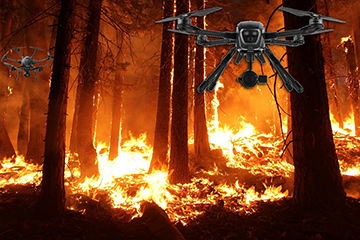Surrounded by advancing lava flows from the erupting Kilauea volcano in Hawaii, one terrified but fortunate islander’s life was saved by an improbable rescuer – a drone. The drone was utilized in the emergency response to the disaster and was used to lead the trapped victim to safety.
This and other successes resulting from the proliferation of drones as credible tools in emergency situations has led to a remarkable increase of 82 percent in drone use among public safety agencies in the U.S. just in the last year. Today, nearly 1,000 public safety agencies across the country own at least one drone, according to a report by New York’s Bard College.
In addition to rescues, drones are also assisting with incidents involving wildfires, motor vehicle accidents, prison monitoring, crowd control and during natural disasters. Because of their relatively inexpensive cost and maintenance and their versatility, they have become the principal technological form of surveillance by air.
Drone program use has increased steadily among public safety agencies since 2009, but has exploded in the last few years. Only about 150 programs were established from 2009-2015, but in 2016 another 250 were initiated, followed by 334 last year and 120 so far this year, according to the Bard report.
Take a look at how drones are distributed among public safety agencies in the U.S. Of the 910 agencies with drones, 302 are owned by sheriff or county police departments, 278 belong to municipal police departments, 186 are municipal and county fire or EMS and the remainder belong to municipal and county emergency management and public safety agencies or statewide public safety agencies.

Among the recent agencies to add drones to its public safety tool kit is the Bossier Fire Department in Bossier City, Louisiana. City officials there appropriated $30,000 to purchase three drones. One will be used for training and the other two will be used in the field for incidents such as missing person searches, search and rescue missions, disaster recovery and assessment, hazardous materials spills or major structure fires.
Smaller-sized cities also are turning to drones to increase the capabilities of their law enforcement agencies. The Pelham (Alabama) Police Department in April added a second drone. And like many law enforcement agencies facing budget cuts or budget gaps, Pelham was able to secure a donation from a local public service organization that covered the $4,000 cost of the drone. A fundraiser in Hewitt, Texas, netted the $6,000 needed by the police and fire departments for the purchase of a drone, its licensing and training of personnel.
In Dodge City, Kansas, the police department increased its ability to investigate cases such as missing children, vehicle crashes and fires by adding a pair of drones. Kitsap County, Washington, sheriff’s deputies report that a motor vehicle accident was cleared in minutes with the use of their recently rolled-out drone program, where a traditional accident investigation involving numerous officers and vehicles would have taken hours.
The cost of drones runs the gamut. Kitsap County officials paid $1,500 each for their drones bought from a local national discount house. On the other hand, city officials in Back Mountain, Pennsylvania, are planning to purchase a $32,700 military-grade drone. Funding will be provided from state grant funds for shared police equipment that was secured by a community partnership of area towns.
Many of the “Big Brother” fears of the public when drones were first introduced into law enforcement and public safety have been allayed by both regulations at the local, state and federal levels of government as well as by the many instances in which they have been used successfully to enforce the law and ensure public safety. Drone use is expected to continue to expand as agencies realize they are important tools that can increase efficiency and avoid putting emergency personnel at risk – and at minimal cost.
SPI’s government contracting consultants assist firms of all types in selling to government. Contact them today.






